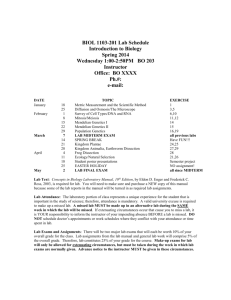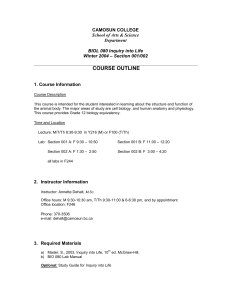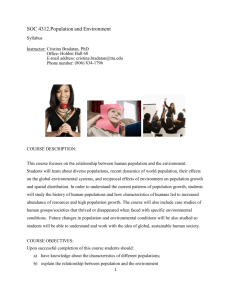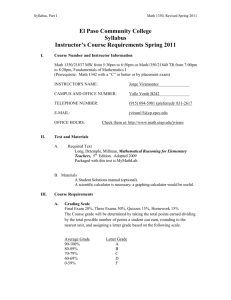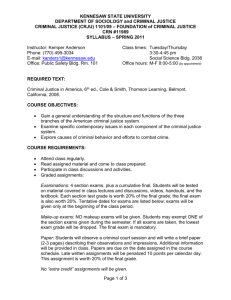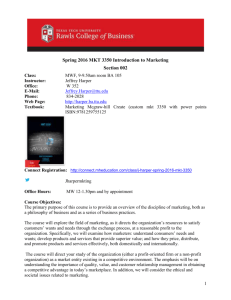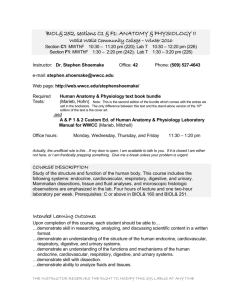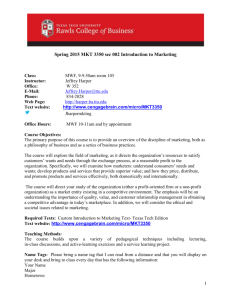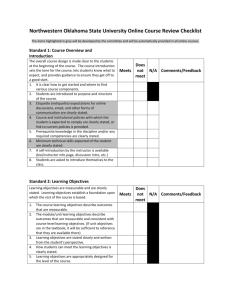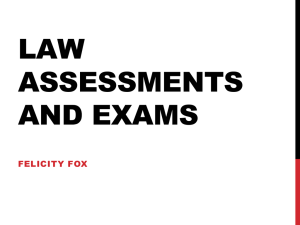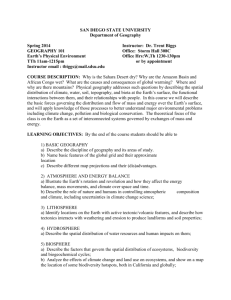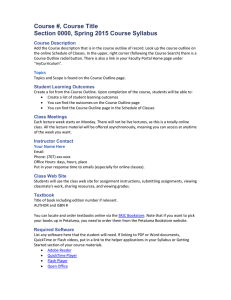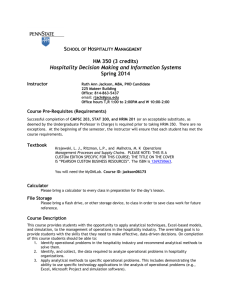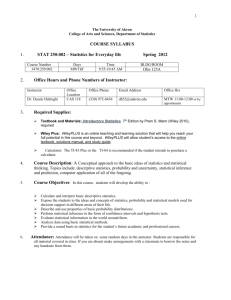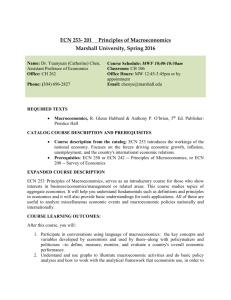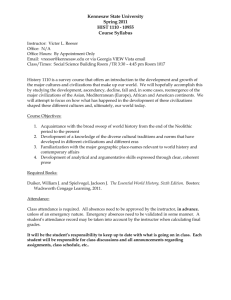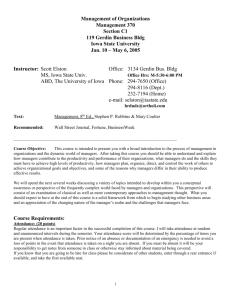BUSINESS MARKETING & LOGISTICS 450D
advertisement
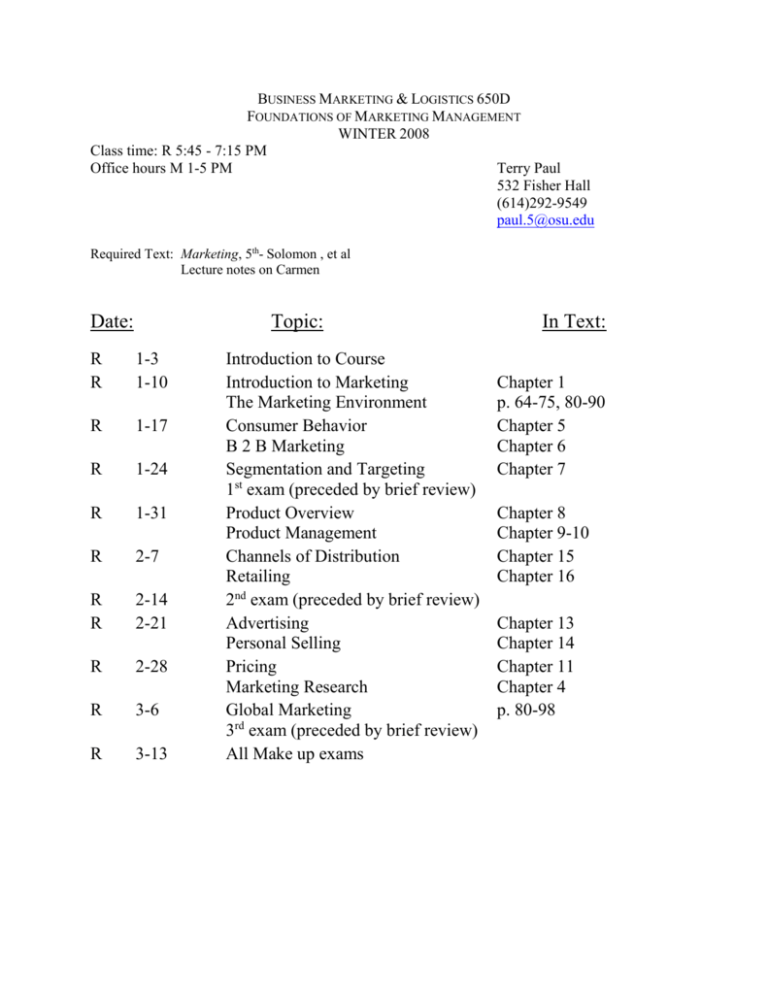
BUSINESS MARKETING & LOGISTICS 650D FOUNDATIONS OF MARKETING MANAGEMENT WINTER 2008 Class time: R 5:45 - 7:15 PM Office hours M 1-5 PM Terry Paul 532 Fisher Hall (614)292-9549 paul.5@osu.edu Required Text: Marketing, 5th- Solomon , et al Lecture notes on Carmen Date: Topic: R R 1-3 1-10 R 1-17 R 1-24 R 1-31 R 2-7 R R 2-14 2-21 R 2-28 R 3-6 R 3-13 Introduction to Course Introduction to Marketing The Marketing Environment Consumer Behavior B 2 B Marketing Segmentation and Targeting 1st exam (preceded by brief review) Product Overview Product Management Channels of Distribution Retailing 2nd exam (preceded by brief review) Advertising Personal Selling Pricing Marketing Research Global Marketing 3rd exam (preceded by brief review) All Make up exams In Text: Chapter 1 p. 64-75, 80-90 Chapter 5 Chapter 6 Chapter 7 Chapter 8 Chapter 9-10 Chapter 15 Chapter 16 Chapter 13 Chapter 14 Chapter 11 Chapter 4 p. 80-98 SOME WORDS TO THE WISE The material in introductory courses like the Principles of Marketing and Principles of Psychology often seems very familiar (unlike subjects such as physics or chemistry). Unfortunately, this familiarity can give students a false sense of security in a feeling that they have mastered the material with relatively little effort. These students frequently lament that “the text and lecture are just common sense but somehow I failed the exam”. Expect test questions to probe for more depth and detail than you can easily handle with a light skimming of the text and a passive listening to lectures. Half your grade in the course will be determined by assignments (written and oral) related to an organization you choose for applying the course principles to and half will be based on your performance on three exams. The Columbus campus version of this course is a large lecture class in which the grade is based almost entirely on exam scores. The learning experience for students on the regional campuses is potentially richer. This means you can get more out of the course in terms of career preparation, “pure education”, and simple enjoyment. BUT ONLY IF YOU PUT THE EXTRA EFFORT INTO IT. It takes a good deal of motivation and self-discipline to work steadily thru the video lectures and related chapters. How much you get out of this material is mainly up to you. But, again, it can be more than for students on main campus. MAKING MARKETING STRATEGY MORE RELEVANT – FOCUSING ON YOUR ORGANIZATION Textbook treatment and class discussion of a business subject often remain remote and abstract unless you can see some practical payoff in terms of meaningful real world applications. To facilitate this kind of learning experience, each student will choose an organization to view as their own focus and as a continuing case study in the application of concepts and issues from BUS M&L 650. As part of each student’s daily preparation for class, careful consideration of how topics from the assigned chapters might apply to your organization is expected. As you read each chapter, think hard about its relevance for your organization. Students should imagine themselves as marketing strategy specialists advising their organizations about these concepts. The easiest way to select your organization is to choose one 1. 2. 3. 4. for which you have worked that you have patronized extensively in which you know managers well that is discussed in the media, texts, etc. This organization can be large or small, for profit or not for profit, but it must be currently in operation. The choice of your organization is a very important decision which you need to make carefully but quickly. It should obviously be one you find interesting and one for which you feel confident about applying course concepts to. Usually you’ll need to speak hypothetically (what you think rather than what you know to be true from experience and observation) in discussing the relevance of course concepts to your organization. How creative and insightful you are in completing these assignments will be taken into account in grading, as will the inherent difficulties your organization presents to you as a subject for these reports. For your first report describe the 4 Ps of marketing as introduced in Chapter 1 and in the first video as these concepts apply to your organization. Besides talking about “the whats”, strive to get beneath the surface to talk about the “hows” and “whys” the organization carries out the 4Ps as it does. Show how all of these things connect to the customers your organization targets. Your first report is due on Jan. 15th (or Jan. 8th if you want the 25% “early bird bonus“ added to your grade on this assignment). The suggested length for this report is at least 3 typewritten doublespaced pages. The main purpose of the report is to push you to make a prompt but considered choice of the organization on which you will concentrate in this course. This report will serve to familiarize the instructor with your organization and your own involvement with/interest in it. If your organization is a large one with a number of divisions/locations, you have some decisions to make about what part(s) of the organization to concentrate on in your reports. For example, if you work for Bath & Body Works, you might focus on marketing issues for the company as a whole or ones limited to your particular store or a combination of both. When in doubt, choosing the areas in which you have the most knowledge and experience, the strongest opinions, or the greatest interest will serve you best. This first report will account for 10% of your grade in the course. Pretend that this report was being prepared for your organization’s biggest competitor. Pack as much information into its 3 pages as you can about the organization’s marketing strategy as you understand it. On a separate page, briefly (about half a page) describe your own involvement/interest in the organization. Attach this information to the back of your report. Another 20% of your grade in the course will be determined your second and third reports (10% for each report). The basic requirement of these relevance reports is that you take one or more topics treated in the chosen chapter and show how they relate to the operations of your organization. The idea is to demonstrate the relevance of the text discussion to the organization on which you are focusing. Explain how the authors’ discussion applies to the way this organization does business. Both similarities and dissimilarities can be considered. SOME STRONG SUGGESTIONS CONCERNING THESE REPORTS 1. Don’t waste space on background (historical, non-marketing, etc.) material; if some of this is essential to the understanding of marketing issues, include it but be very concise. 2. USE HEADINGS WITHIN YOUR PAPER to organize your thoughts and to make it easier for the reader to appreciate them. 3. As much as possible, go beyond mere description (what) into analysis (how and why). 4. Strive to remain objective in these reports; don’t come off as a “cheerleader” for your organization. 5. Look for areas of improvement, come up with constructive criticism. 6. There is no penalty for going beyond the suggested length on your reports but don’t waste words, paper, and time. Quality is more important than quantity in what you have to say in these reports. If you’re aiming for an A grade on these reports and in the course, put extra effort into these assignments in terms of quality and quantity. 7. Creativity and insight in applying the text topics are high priorities of these reports. Their presence demonstrates that you have fully understood the relevant concepts and applied them thoughtfully. A report that adequately but routinely fulfills the requirements of this assignment will receive a B- grade. 8. Quality is more important than quantity in these reports. Acceptable reports generally average about 3 typewritten double-spaced pages. Good reports might be somewhat shorter than this but remember that you need to demonstrate the considerable time and effort you have put into their preparation. If your report is much less than 3 pages, the burden of proof is on you. There is no penalty for extending your report beyond average length but make sure that all of your report is meaningful material in order to receive full credit for it. Again, if you are aiming for an A grade, put extra effort into these assignments in terms of quality and quantity. Relevance Report Due Dates Topics from To be submitted by Covered in class Part One of Course: Chapter 1 Jan. 8 or 15 Jan. 10 and 17 Part Two of Course: Chapter 8/9/10 or Chapter 15/16 Jan.29 Feb. 5 Jan. 31 Feb. 7 Part Three of Course: Chapter 13/14 or Chapter 11/4 Feb. 19 Feb. 26 Feb.21 Feb. 28 Class Participation All students are expected to attend class regularly. Attendance will be taken at the beginning and end of class. Students who attend 90% or more of the classes will earn a 6% bonus on their final course grade. 80% - 89% attendance earns a 3% bonus. The instructor will attempt to draw students into active participation in class. You may be asked questions about the day’s reading assignment, something from the lecture, current events in marketing, or ideas expressed by another student. In any case, you are expected to respond thoughtfully. Often you will be asked how something could affect your organization. At a minimum, this requires that you be prepared for all questions from having thoroughly read the day’s assignment and paying close attention to everything that is said in class. Since you are only one of a number of students, try to make your responses concise and to the point. Be sure that you can be heard. Finally, courtesy is to be shown at all times during discussion in the form of due respect, particularly to your peers. Class participation will account for 20% of your grade in the course. You are absolutely expected to be in class the days your reports are to be covered. Make a copy of each of the reports and be VERY familiar with all you said in them. Be WELL prepared to discuss this material in class. HOW CLASS WILL BE CONDUCTED Except for the very first day and days of exams, each class will begin in a “business meeting format”. By this it is meant that students should behave as they would at an important meeting at work. On Jan. 10th students who have written reports to discuss should sit at the front of the class. By Jan. 17th there will be a seating chart so on that day and for the remainder of the quarter, sit in your assigned seat. Be sure to be in your seat by 5:40 p.m. when attendance is taken. Attendance (just being physically present without saying a word) will account for half of your class participation grade. To give you a rough idea, if you are always present in class and NEVER say anything, you will still earn a B- for 20% of your overall course grade for class participation. Beyond that, what you say in class will generally add to your participation grade. Being absent, PARTICULARLY when you have a report that might be discussed, will lower your participation grade. EXPECT to be called on the days your report is being discussed. But even if you have not submitted a report on the topics of the day, you might be called on. On days of exams the instructor will answer questions from 5:45 – 6 PM. The test will begin at 6 PM. Class is over on these days when you’ve completed the exam. Pictures To help the instructor to learn names and faces quickly, you are requested to submit a picture at least 2 inches X 2 inches (head shot) of yourself. If you turn your photos in by Tuesday Jan. 15, you will receive a 1% extra credit bonus added to your final grade. Please submit photo online (instructions provided at your campus) About You Students enrolled in this course are professionals in training and will be treated accordingly. It is expected that you will almost always be present in class. Arriving late or leaving early should be very rare occurrences – consider how you would react to others doing these things for a business meeting that you were conducting. Similarly, do not signal your impatience to leave class by “packing up” or any other non-verbal behavior before all discussion is concluded EXAM INFORMATION There will be 3 exams, each consisting of 40 multiple choice questions. Together these three exams will account for half your grade in the course. Each exam will cover only the material for that third of the course. Your two highest test grades count 20%, your lowest 10 % of your overall grade in the course. Exam questions are derived as follows – roughly ¼ from lecture material alone, ¼ from assigned material in the text alone and, ½ jointly from the lecture and text. All chapters – topics are not equally important; the exact allocation of exam questions will be announced in class the day before the tests. If you miss a midterm exam, you will be required to take an essay exam over that material as a make-up during finals week. The textbook is full of examples which relate to particular organizations and their marketing activities. In general you should concentrate on the basic concepts, the marketing principles these examples illustrate, rather than trying to remember what a specific company did. There will be very few questions on each exam that ask about textbook examples by the name of the organization. SOME SUGGESTIONS - READ ASSIGNMENTS CAREFULLY, TAKE NOTES, OR UNDERLINE WHAT YOU READ. CLASSROOM COURTESY Students attending class must be considerate of each other to make the learning experience productive and congenial. Here are the ground rules: 1. In general, do not behave in any way that would be a distraction to other students; for example, loud and animated conversations during class are annoying and inappropriate— refrain from them. 2. Cell phones and other electronic media should not be audible in class. 3. If you must enter the room after the lecture has begun or leave before it is over, do so as quietly and as inconspicuously as possible. 4. If another student acts in a manner than is distracting to you, politely ask him/her to stop it. (He/she might not realize the behavior is bothersome.) If it persists, inform the instructor.
